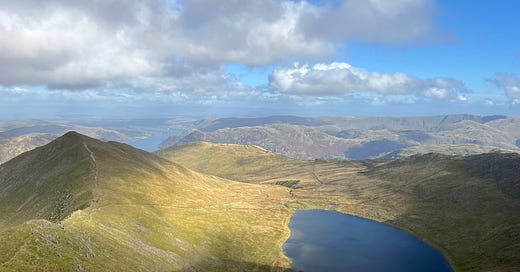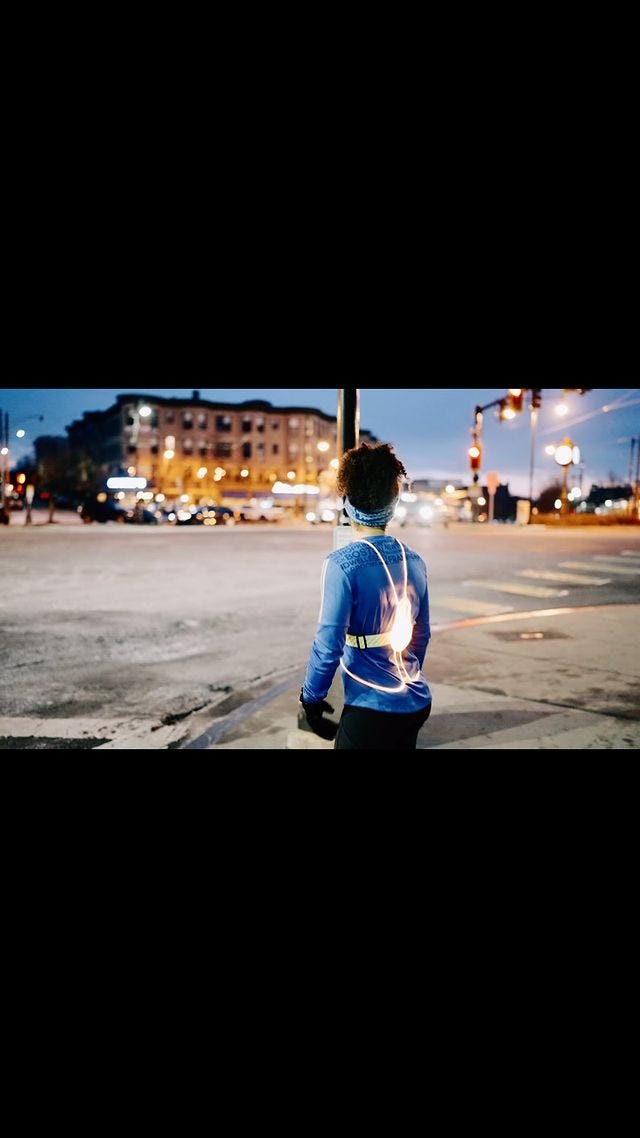Running safe & managing risk after yet another death
Things to consider and what does 'safe' mean?
Feeling safe while running encompasses so many different aspects. There’s the daytime and nighttime aspect; there’s the feeling of being safer solo in a rural place than in a big city, and there is the opposite of that too.
There are so many different factors for every individual, location and type of running. Feeling safe doesn’t mean you are safe; all we can do is manage risk.
It occurred to me this week that I feel much safer running solo on the hills in Cumbria than I do in the dark in central London.
Growing up in the north-west, my only safety considerations when running were always taking a phone and a jumper.
Cycling in the back of beyond in Lancashire and Yorkshire was a bit different. Safety concerns were more accident and mechanical related. For example, having phone battery and signal in case of emergency, not falling off my bike or hitting any rogue farm animals on the lanes, and having enough food and drink to get you back to civilisation.
Running is less mechanically dangerous; however, we have all fallen over and hurt ourselves at some point. In off-road running, we all know stories about capable runners who went out on the hill and never came back.
What did occur to me on those bike rides towards the end was that if I had an accident or a mechanical issue there was no phone signal or houses to call for help (even worse now many are holiday lets and predominantly empty). You might be lucky if a car passes by.
Occasionally, I had visions that if I fell off from hitting a pothole or a sheep darting out and seriously injured myself (believe me, it happens), nobody would find me for hours or even days. Eventually, I stopped riding solo in those parts because it freaked me out too much. Not long after, I relocated to the city.
Those were all safety considerations of circumstance and environment — things you can avoid, like potholed roads or rerouting away from agile sheep or poorly lit areas.
Ironically in the rural cycling cases, having a connection to the world made me feel safe because it feels like more can go wrong on a bike than on two legs. Whereas running in the city, it’s other people who tend to make you feel unsafe.
When I moved to Manchester and later London it was something I became suddenly aware of. At university, there were stories of fellow students being harassed, assaulted or worse in the park next to our campus in Salford. Sometimes it was during the day, other times at night.
Safety concerns feel heightened at night when more is out of your control. Previously my concern was ‘do I need a head torch?’ and now it was ‘am I going to be attacked if I run this way in the dark?’ Sometimes it was best to not run at all.
These considerations started at university and continue today. When I lived in London and left the office at 11pm after a shift, the journey home was extremely uncomfortable. Choosing not to read, use headphones or look at your phone on the tube in case someone approached you. Checking over your shoulder every minute or two on the short walk between the station and home.
The difference between the daytime and nighttime journey was massive.
In summer running down the Thames Path is a dream as it’s generally warm, daylight and you might even get a sunset. Safety is the last thing on your mind. But in winter when the nights draw in, the choice of post-work exercise is more considered and safety suddenly feels like a high priority.
Although nighttime may feel more dangerous, it doesn’t stop people from being attacked in broad daylight.
Earlier this month, a woman was killed while she was out for a run during the day on a popular trail in Nashville, Tennessee, in the US. According to reports, Alyssa Lokits, 34, was followed by a man who tried to sexually assault her, and when she screamed for help he shot and killed her.
In September 2022, Eliza Fletcher was brutally kidnapped and murdered while running near her home in Tennessee.
It’s not just in the US. In July this year, a woman was sexually assaulted while out running in Kettering. Even closer to home, numerous women in Kendal have previously reported a man who follows and approaches women on Scout Scar.
I’ll spare you more examples. For further reading, someone created a Wikipedia list.
Research by Manchester University from earlier this year shows women bear the brunt of abuse. Of the women surveyed in Manchester and Liverpool, 82% said they worried about their personal safety whilst out running.
“The respondents took a magnitude of measures to enhance their feeling of personal safety, including taking other items for safety alongside their phones such as their keys (held between their fingers as a weapon), watches (Apple watches, Garmin or Strava), personal alarms (including rape alarms), dogs and lights or reflective clothing.”
You may have seen the recent clip of Saoirse Ronan on The Graham Norton Show silencing the male guests during an anecdote about what to do if you’re being attacked.
“That’s what girls have to think about all the time”, she said. “Am I right ladies?”
Looking less threatening
On the flip side of personal safety, there’s the consideration of how you may appear to others.
I remember talking to Sabrina Pace-Humphreys, one of the co-founders of Black Trail Runners, for a piece I did a few years ago on diversifying the outdoors. One of the things we talked about was the trouble for people of colour, and men in particular, looking “less threatening” while they’re out.
"It's all in the actions, it's in the stares, it's in the me as a 43-year-old mixed race woman running in the woods and people physically jumping out of the way as if I'm going to rob them. All I'm doing is enjoying a run.
"Those things, time and time again, make you think, 'I won't run there anymore' or 'How can I make myself look less threatening?'
"I'm a 43-year-old woman, imagine what it's like for a young Black man."
There’s a lot to think about no matter who you are, which is why personal safety is so unique to the individual and what they’re comfortable with. It comes down to managing risk.
I feel safer on the hills in the north because it’s an environment I’m used to and I take the right precautions for the terrain (listed below). In central London at night, the precautions are choosing roads which are brightly lit, and avoiding secluded areas, perhaps not using headphones. That’s not to say I couldn’t be attacked on a hill by a stranger.
It’s a bit of a minefield when you get into the weeds of what precautions to take, and I don’t have all the answers or solutions. Ideally, people should stop attacking and murdering other people and perhaps we would all feel safer.
If you need a lesson on why you should tell someone where you’re going, read Things I Learned from Falling, by Claire Nelson. It’s a hugely gripping and powerful memoir and it made me reevaluate my own blackspots to safety when out on the hills.
Rules to live by:
Here are some guidelines we have in our household for managing risk during outdoor activities:
Tell someone where you’re going, and how far/ how long you expect to be out and when you’ve finished
Keep in touch - send a message with the location or summit every now and then & write the time of day on the message in case it comes through late (Esk Pike, 12:09pm)
Use tracking devices - Find my iPhone, Garmin Livetrack, Strava Beacon, or other equivalent software. They’re not perfect when you haven’t got signal but they’re better than nothing
Take appropriate clothing, equipment just in case - food & drink, head torch, coat, gloves etc.
Take a (charged) phone even if it’s only a short jaunt - it might not be for you, but someone you come across!
Be realistic with the route choice
Another thing to consider is if you’re attempting a solo/unsupported route, perhaps don’t publically share a tracking link so anyone can find and approach you.
If you have additional tips, send them along and I’ll share them next week.








